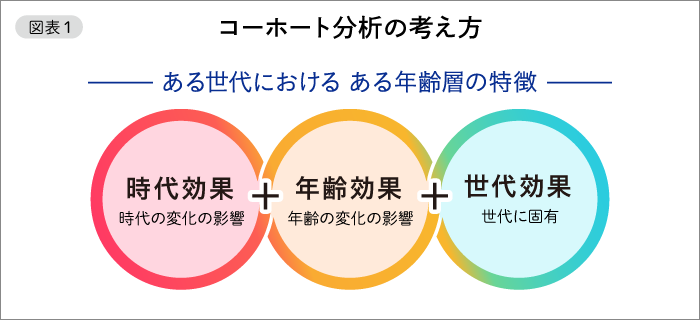Last time, we introduced the results of analyzing women's generational values and tendencies in five-year increments. While this time's content differs somewhat from what was previously announced, we will further explore the overall landscape of digital services based on the cluster analysis introduced in Part 2.
Recently, women have been actively using PCs and smartphones to access various digital services. What factors drive this usage? While this analysis does not constitute a full-scale cohort analysis using time-series data (*), we will employ its methodology to qualitatively examine three effects.
(*) The term "cohort" originates from the unit of legions in the ancient Roman army. Cohort analysis involves examining the lifestyles, values, awareness, and behavioral patterns of people born in the same era. Individuals born within the same period—that is, members of the same generation—are said to share common values due to the "generational effect," as they experience similar societal influences regardless of changes in the times [era effect] or their own aging [age effect].
Influenced by new phenomena of each era ~ "Era Effect"
Not only new tools with transformative value, like the smartphone revolutionizing communication, but also societal systems and events driving change can alter values and consciousness. For instance, the arrival of the "100-year life era," a topic gaining traction around 2018, forced people to plan for 40 years of life after retirement, potentially shifting consumption attitudes.
Other experiences, such as the burstingofthe bubble economy,the Lehman Shock, and more recently the COVID-19 pandemic, can also foster an atmosphere that values a more prudent lifestyle by fundamentally reevaluating one's outlook on life and society.
Such events become the standard for their respective eras, ultimately playing a role in shaping values and consciousness as a kind of "era effect."
Changes in Digital Services Used for Childbirth and Child-Rearing ~ "Age Effect"
Among the important life events for women—marriage, childbirth, and child-rearing—marriage status varies, with some unmarried and others married, and the age of first marriage differs significantly by person and region (according to the Ministry of Health, Labour and Welfare, the average marriage age in 2018 was 31.1 years for men and 29.4 years for women). However, when it comes to the stage of childbirth and child-rearing, the nature of digital services used by women appears to change.
The combined percentage of those who " use frequently " or "use occasionally" the digital service Mamari, which addresses questions and concerns of expectant and new mothers, was 35.4% among the feature phone generation (late 20s) and 31.8% among the Yutori education generation (early 30s), indicating approximately one in three users.
As evident in the second installment, digital services for childbirth and childcare form a distinct cluster with unique positioning.
Beyond the life stage changes mentioned above, it's only natural that when new digital services emerge, younger generations tend to adopt them more readily than older age groups. Looking at Figure 2, the video-sharing service TikTok stands out across all generations, with 32.2% of the catch-up generation (late teens) combining "use frequently" and "use occasionally." Similarly, the image editing service PicsArt reaches 59.7%. These digital services have become indispensable for communication among younger generations.
Conversely, some digital services are used more by older age groups. This suggests that as values and awareness are formed, there are aspects influenced by aging, akin to an "age effect."
Significant Influence of Information Exposure During Value Formation Period ~ "Generational Effect"
Reviewing the content from Part 3 makes it clear: examining five-year age brackets reveals distinct differences in values and awareness across generations. Spanning 12 generations from the Catch-Up Generation to the Baby Boom Generation, with five-year increments covering 60 years, we observe highly diverse generational characteristics. Beyond information services like Windows 95 and i-mode mobile phones, content such as Ai Yazawa'smanga and fashion-focused women's magazines significantly shaped values and awareness.
Regarding communication methods, as seen in the first installment, language and expressions familiar to specific generations are required. A major food manufacturer produced a TV commercial featuring a virtual talent with the creative tagline "Ari yori no Ari" (lit. "More real than real"). This appeal is precisely targeted at today's younger generation who understand the meaning of the phrase and resonate with the virtual worldview.
While such initiatives represent advanced targeting, the groups showing affinity for the communication methods introduced here will likely carry forward generational effects, maintaining their unique sensibilities into the future.
Finally
According to cohort analysis, each generation transforms its "way of being" while embracing changes in era and age, based on its unique values. Particularly, the generation poised to become the core of society and the main drivers of consumption—what kind of media environment will they inhabit? What language will they use? What digital services will they adopt? The themes for insight research into female audiences will never run dry.
This concludes the series. Thank you for your continued interest.
[Survey Overview]
● Survey Name: 12-Tier Female Age Group Survey
● Target Areas: Kanto (Tokyo/Kanagawa/Saitama/Chiba), Chubu (Aichi/Gifu/Mie), Kansai (Osaka/Kyoto/Hyogo/Nara)
● Target Criteria: Women aged 15–74
●Sample Size: 3,000 respondents
●Survey Method: Internet survey
●Survey Period: November 1–5, 2019
●Research Organization: Video Research Ltd.






